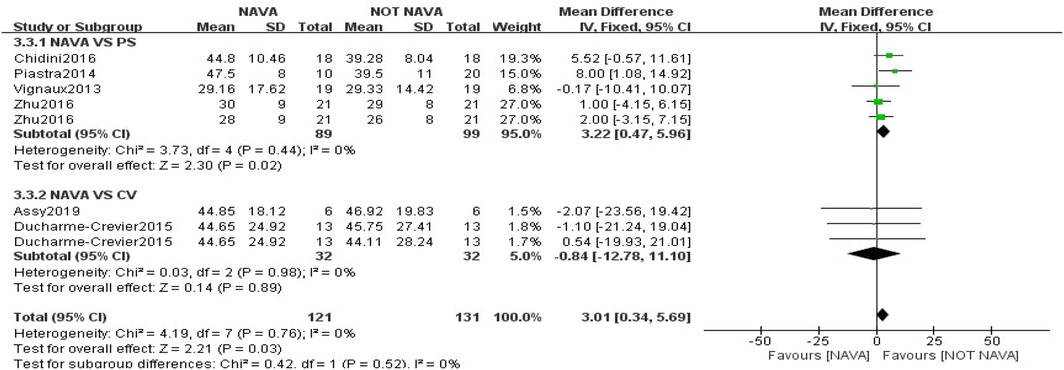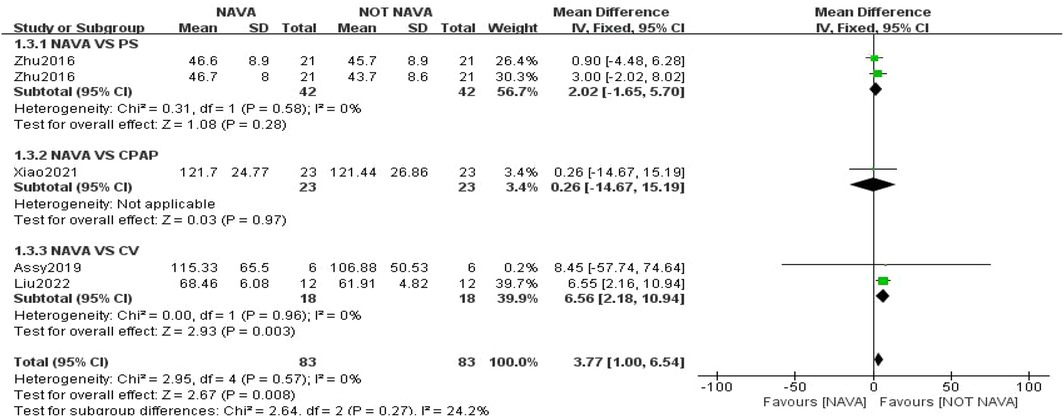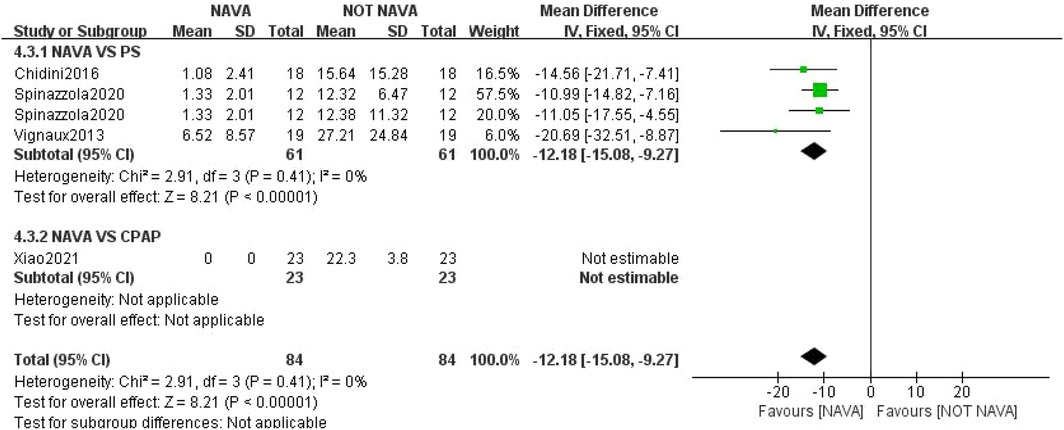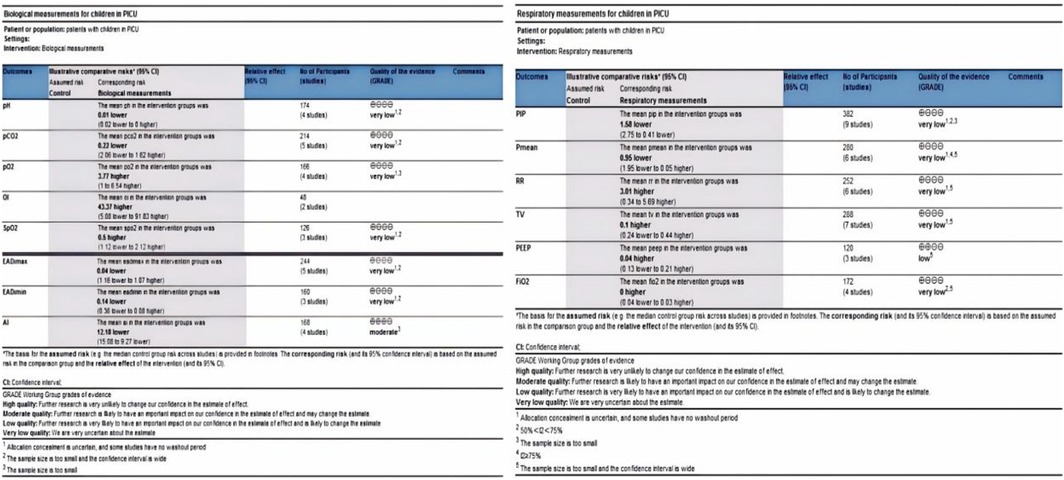- 1Department of Nursing, Children's Hospital of Nanjing Medical University, Nanjing, China
- 2Department of Nursing, Yancheng First Hospital, Affiliated Hospital of Nanjing University Medical School, Yancheng, China
- 3Department of Nursing, The First People's Hospital of Yancheng, Yancheng, China
- 4Department of Nursing, Suzhou Municipal Hospital, The Affiliated Suzhou Hospital of Nanjing Medical University, Suzhou, China
- 5Emergency Department, Children's Hospital of Nanjing Medical University, Nanjing, China
- 6Department of Rehabilitation Medicine, Children's Hospital of Nanjing Medical University, Nanjing, China
- 7Department of Nursing, Nanjing BenQ Medical Center, The Affiliated BenQ Hospital of Nanjing Medical University, Nanjing, China
Background: Patient-ventilator asynchrony is a common problem in mechanical ventilation, leading to an increase in MV complications. Neurally adjusted ventilatory assist (NAVA) is a relatively new modality of mechanical ventilation that can be used for both invasive and non-invasive ventilation. There is evidence that NAVA reduces asynchronous events, but the sample size is small and the effect on specific physiological and clinical outcomes in children is controversial. Therefore, we conducted a systematic review and meta-analysis to evaluate the effect of NAVA on physiological parameters and clinical outcomes.
Methods: We searched electronic databases up to 26 September 2024. Clinical trials comparing NAVA with conventional mechanical ventilation modes were included. The primary outcomes were physiological parameters, respiratory parameters, ventilator-related parameters, and other clinical outcomes. Two review authors independently extracted data and assessed study quality using the Cochrane Risk of Bias tool2. The certainty of the evidence was assessed according to the scoring methodology. Apply meta-analysis as much as possible, and use qualitative analysis when conditions are not met.
Results: Eleven studies involving 224 children met the inclusion criteria for this review. Four were randomized cross-over trials, three were prospective cross-over trials, and four were retrospective studies. There were significant differences in the methods and quality of the included studies. Meta-analyses revealed significant differences in PIP, RR, pO2, and the asynchronous index (AI) when compared to traditional modes of mechanical ventilation. However, no significant differences were observed in FiO2, PEEP, TV, pH, pCO2, SpO2, EAdimax, and EAdimin.
Conclusions: This systematic review and meta-analysis suggest that while NAVA has advantages for certain short-term physiological outcomes, the level of evidence remains low. Consequently, larger and higher-quality studies are necessary to identify potential short- and long-term differences between various ventilation patterns.
1 Introduction
Mechanical ventilation (MV) is an essential life support technique applied in the Pediatric Intensive Care Unit (PICU). The clinical application of mechanical ventilation can significantly enhance the success rate of rescuing critically ill patients while also reducing morbidity and mortality. However, in traditional ventilation modes, discrepancies between actual ventilation demands and the level of ventilation can lead to patient-ventilator asynchrony (P-VA). When children use pressure support mode (PS), the proportion of asynchronous time that occurs is as high as 33% (1). Among the many complications that could arise from this asynchrony are ventilator-induced lung damage and ventilator-induced diaphragm dysfunction (VIDD) (2, 3). To mitigate these undesirable outcomes and address asynchronous issues, the development and refinement of ventilation modes present a necessary challenge.
Neurally adjusted ventilatory assist (NAVA) is a relatively new mode of mechanical ventilation that can be utilized for both invasive and non-invasive ventilation. It relies on the electrical activity of the patient's diaphragm to generate respiratory effort (4, 5). Changes in diaphragmatic electrical activity at the onset of inspiration occur before changes in pressure and flow at the airway opening, allowing NAVA to have a shorter trigger delay compared to conventional ventilation modes (4). Additionally, it can adjust the intensity of ventilation to meet the patient's needs (6). This enhanced interaction between the patient and the ventilator reduces the rate of asynchrony. Previous pediatric clinical studies have demonstrated a significant improvement in synchrony with the ventilator when using NAVA (7, 8).
However, controversy persists regarding the differential effects of NAVA on physiological and clinical outcomes in children, as all studies conducted to date have small sample sizes. Therefore, this study aimed to synthesize various pediatric studies to evaluate the impact of NAVA on physiological parameters and clinical outcomes in comparison to the conventional mechanical ventilation (CMV) model.
2 Methods
The review protocol was registered prospectively in PROSPERO (CRD42024577790). The report of this study was presented in accordance with the guidelines of the Preferred Reporting Items for Systematic Reviews and Meta-Analyses (PRISMA), and the checklist was provided in the Supplementary Materials (9).
2.1 Eligibility criteria
2.1.1 Inclusion and exclusion criteria
The study established the following inclusion criteria: (a) a comparative study of NAVA vs. CMV during mechanical ventilation in pediatric subjects; (b) data for at least one endpoint of interest for each group; and (c) the study must involve only pediatric patients aged under 18 years. Newborns were specifically excluded due to their classification as a distinct demographic. Furthermore, children with congenital anomalies, neuromuscular diseases, diaphragmatic paralysis, or palsy were also omitted from the analysis. We also excluded studies that inadequately reported data.
2.1.2 Outcomes
The outcomes of interest in this study were summarized into four broad categories: respiratory measurements, Physiological measurements, ventilator parameter correlation, and others (total duration of mechanical ventilation, length of stay in the PICU, and incidence of adverse events).
Respiratory measurements—respiratory rate (RR), fraction of inspired oxygen (FiO2), peak inspiratory pressures(PIP), mean airway pressure, positive end-expiratory pressure(PEEP), tidal volume (TV).
Physiological measurements—pH, pCO2, pO2, oxygen index (OI), oxygen saturation (SpO2).
Ventilator parameter correlation—electrical diaphragmatic activity(EAdi) including maximum EAdi (μV) and minimum EAdi (μV), asynchrony index (AI).
Asynchronous events are the lack of coordination between the respiratory activity of the patient and the mechanical assistance provided by a ventilator (10). These asynchronies are classified into five types: (a) ineffective triggering; (b) double triggering; (c) auto trigring; (d) premature cycling; and (e) late cycling (7). The Asynchrony Index (AI%) is a widely used metric for quantifying the rate of asynchrony. It is calculated by taking the ratio of the number of asynchrony events to the total number of respiratory cycles, which includes both ventilator-triggered cycles and non-triggered breaths (11).
2.2 Sources of information and search methodology
Until September 26, 2024, the electronic databases referenced include PubMed, Web of Science, Cochrane Library, CINAHL, CNKI, VIP, Wan Fang, and Sinomed. Depending on the database used, the search terms included MeSH terms and text words, along with free keywords combined using the Boolean operators “AND” and “OR” (Supplementary Table S1). Studies in any language and from any country would be accepted. The reference lists of the included studies and previously published systematic reviews were manually reviewed.
2.3 Study records
2.3.1 Selection process
The database was searched by the principal investigators (CWQ). Two reviewers (CWQ, ZYH) carried out the literature screening process independently and then compared their findings based on established inclusion criteria. Disputes would be settled either by conversation or by seeking advice from a third-party examiner (MY).
2.3.2 Data collection process
Using a pre-structured form, two independent reviewers (CWQ, ZYH) gathered data to collect general information and research characteristics. We performed calibration activities before the evaluation to maintain consistency among the reviewers. If needed, we reached out to the original article's author for further information. In the end, a third reviewer (MY) or a consensus method would be used to address any discrepancies.
2.4 Data items
The following details were extracted: study information (name of the first author, year of publication, country); type of study; sample (characteristics and number of subjects); intervention definition; control definitions; and various outcomes. If only the median and (interquartile range) ranges are reported, the normality of the data is checked using the method described by Shi et al. (12) Subsequently, the sample mean and standard deviation (SD) were estimated using the methods of Luo et al. (13) and Wan et al. (14).
2.5 Study risk of bias assessment
Two reviewers (CWQ, ZYH) independently evaluated the bias of randomized controlled trials (RCTs) and randomized studies using the Cochrane Risk of Bias Tool 2 (RoB 2) (15). Bias across seven domains of non-randomized intervention studies was assessed using the ROBINS-I Tool, Version 1—2016 (Risk of Bias in Non-Randomized Intervention Studies) (16). Other types of studies were evaluated using the Newcastle-Ottawa Scale(NOS). We would utilize RevMan 5.4 (Review Manager 5.4) to create a visual representation of potential bias within and between studies regarding random assignment. We did not view the lack of blinding as an issue, as blinded ventilation is virtually impossible. Furthermore, knowledge of the interventions received is unlikely to affect the outcomes selected for this review.
2.6 Data synthesis
Statistical software RevMan 5.4 would be utilized to combine and calculate each outcome, adhering to the statistical guidelines outlined in the current edition of the Cochrane Handbook for Systematic Reviews of Interventions. In cases where data were inadequate for meta-analysis, the results were presented in a narrative format.
2.6.1 Measures of treatment effect
This study used a 95% confidence level and p < 0.05 as the threshold. Continuous outcomes were reported as mean differences (MDs), while dichotomous outcomes were expressed as risk ratios. When there was no discernible variation between the studies, a fixed-effect model was used; otherwise, a random-effects model was used. Subgroup analyses were conducted based on the ventilation pattern of the control group.
2.6.2 Assessment of heterogeneity
We intended to use a standard Chi-square test with an alpha threshold of significance set at p < 0.05 to investigate heterogeneity between comparable studies. We used the I2 statistic to evaluate the degree of statistical heterogeneity, with values exceeding 50% indicating significant heterogeneity.
2.6.3 Reporting bias assessment
When 10 or more studies were included in a meta-analysis, publication bias was assessed by visual inspection of the funnel plot.
2.7 Confidence in cumulative evidence
This study utilized the Grading of Recommendations Assessment, Development, and Evaluation (GRADE) criteria to evaluate the certainty of the evidence for each outcome (17). This framework considers the domains of bias risk, consistency, directness, precision, and reporting bias. The findings were summarized in a table of results.
3 Results
3.1 Search results and study characteristics
A flowchart illustrating the studies included in this review is presented in Figure 1. Following an electronic search, 399 records were found, and after removing duplicates, 273 abstracts were assessed, of which 245 were disqualified during the title and abstract review stage for failing to meet at least one of the eligibility criteria. Among the 28 records examined, 1 could not be retrieved, and 16 were excluded (see Supplementary Table S2 for the reasons for exclusion). The two primary reasons for rejection were inconsistencies in the study population and incomplete data. Ultimately, 11 studies were included for systematic review and meta-analysis (7, 8, 18–26).
A total of 224 participants were included in this review. Three of the studies were conducted in France (22, 23, 26), three in China (18, 19, 24), three in Italy (7, 20, 21), one in Switzerland (8), and one in Canada (25). Among these eleven trials, four were randomized crossover trials, three were prospective crossovers, and four were retrospective studies. There were some differences in the inclusion criteria, as three of the studies specifically focused on comparing the effects of non-invasive NAVA in children with PICU (7, 20, 25). Table 1 presents the characteristics of each included study.
3.2 Risk of bias
The RoB2 tool indicated that two of the four randomized crossover studies were at high risk of bias (Figure 2), and the source of this bias was identified as the lack of a washout period during the crossover process (23, 24). In the three non-randomized studies evaluated using the ROBINS-I tool, both exhibited a moderate risk of bias (Supplementary Table S3), the absence of a washout period during the intervention crossover phase and the failure to report planned outcomes at the conclusion of the studies further compromised study quality (19, 21). For retrospective cohort studies, the NOS scale yielded overall scores ranging from 5 to 7 points. Most studies did not include a non-exposed group for study subjects, controls for confounding factors were not clearly defined, and most studies (75%) assessed as having a moderate risk of bias in terms of adequacy of follow-up (Supplementary Table S4).
3.3 Quantitative analysis
Nine of the eleven studies included in the analysis participated in the meta-analysis, while one study was excluded because its data were presented in median (interquartile) form. The mean and standard deviation were not available, as the authors were not contacted to provide this information; therefore, this study was only included in a narrative format.
3.3.1 Comparison 1 respiratory measurements
The pooled analysis indicated that in nine studies involving 382 children, NAVA had a significant reduction in peak inspiratory pressure (PIP) compared to other forms of ventilation (7, 8, 18–22, 24, 26). The mean difference was −1.58 (95% CI: −2.75 to 0.41), demonstrating significance in both fixed and random-effects models, with an inconsistency index (I²) of 63% (Figure 3). Significant differences in respiratory rate (RR) were observed in NAVA (MD: 3.01, 95% CI: 0.34 to 5.69; six trials, 252 children; I2 = 0%) (Figure 4). For mean airway pressure (Pmean) (MD: −0.95, 95% CI: −1.95 to 0.05; six trials, 280 children; I2 = 76%), positive end-expiratory pressure (PEEP) (MD: 0.04, 95% CI: −0.13 to 0.21; three trials, 120 children; I2 = 20%), tidal volume (TV) (MD: 0.10, 95% CI: −0.24 to 0.44; seven trials, 288 children; I2 = 23%), and FiO2 (MD: −0.00, 95% CI: −0.04 to 0.03; four trials, 172 children; I2 = 55%), no significant difference was found. (Supplementary Figures S1–S4).
3.3.2 Comparison 2 physiological measurements
Physiological measurements include pH, pCO2, pO2, OI, and SpO2. For the results of pO2, our study included four studies involving a total of 166 children (18, 19, 22, 24), and the analysis showed that pO2 was statistically significantly higher in the NAVA group (MD: 3.77, 95% CI: 1.00–6.54). The heterogeneity test yielded an I2 value of 0%, suggesting low heterogeneity (Figure 5). For the outcome of pH, our study included four studies with a total of 174 children (21, 22, 24, 26), revealing no significant difference between the groups (MD: −0.01, 95% CI: −0.02 to 0.00; I2 = 44%). For pCO2 outcomes, our study included five studies involving 214 children (18, 19, 21, 22, 24), and the analysis showed no significant difference between NAVA and other modes of ventilation (MD: −0.22, 95% CI: −2.06 to 1.62; I2 = 43%). For SpO2 outcomes, we analyzed three studies with 126 children (22, 24, 26), which also revealed no significant difference between the groups (MD: 0.50, 95% CI: −1.12 to 2.12; I2 = 0%) (Supplementary Figures S5–S7). Regarding the results for Oxygenation Index (OI), we did not perform quantitative analyses due to inconsistencies in units across the two studies (18, 21). However, the study conducted by Spinazzola et al. (21) demonstrated a significant improvement in OI during the NAVA trial compared to PSV (p = 0.004).
3.3.3 Comparison 3 ventilator parameter correlation
For ventilator-related parameters, we primarily assessed the maximum EAdi, minimum EAdi, and the ventilator asynchronous index (AI). For AI, our study included four studies involving a total of 168 children (7, 8, 19, 21). Among these, three studies compared NAVA and PSV and only one study compared NAVA and CPAP. Compared with the PSV group, the results indicated that the NAVA group (61 participants) had significantly lower AI values compared to the PSV group (61 participants) (MD: −12.18, 95% CI: −15.08 to −9.27; I2 = 0%) (Figure 6). Studies comparing with the CPAP group also showed no asynchronous events in the NAVA group (19). Five studies reported maximum EAdi (n = 244) (7, 18, 21, 24, 25), revealing no significant difference in maximum EAdi between the two groups (MD: −0.04, 95% CI: −1.16 to 1.07; I2 = 0%). Three studies reported minimum EAdi (n = 160) (18, 24, 25), and there was no significant difference in minimum EAdi between the two groups (MD: −0.14, 95% CI: −0.36 to 0.08; I2 = 0%) (Supplementary Figures S8, S9).
3.3.4 Other outcomes
Quantitative analyses regarding the duration of mechanical ventilation, length of stay in the PICU, and the incidence of adverse events during NAVA were not feasible due to insufficient data. Chidini et al. (20) demonstrated a significant reduction in PICU stay [5 [4–7] vs. 9 [6–9.4] days, p = 0.002] and a significant reduction in the incidence of ventilator-associated pneumonia (VAP) [5% [20] vs. 0% [0], p = 0.004] in the NAVA group compared to the PS group. Additionally, Liu et al. (18) reported that none of the children experienced complications related to or following the conversion to NAVA.
3.4 Certainty of evidence
The outcome summary graph (Figure 7) shows the quality of the evidence for the outcomes.
4 Discussion
Based on a limited number of studies exploring the effects of NAVA on children hospitalized in the PICU other than neonates, this systematic review and meta-analysis identified 11 studies involving 224 children. The results indicated significant differences in PIP, RR, pO2, and Asynchrony Index (AI) when compared to traditional mechanical ventilation modes. However, the overall quality of the evidence was very low, with the exception of moderate quality evidence for AI. Regarding clinically relevant outcomes, there is insufficient data to support meta-analyses demonstrating the superiority of NAVA in terms of efficacy.
Meta-analysis indicates that the use of NAVA is associated with lower peak inspiratory pressure (PIP), improved patient-ventilator synchrony, and increased pO2. Furthermore, we performed subgroup analyses of AI by ventilation mode, and even when PSV or CPAP was used as the comparator, NAVA produced a statistically significant decrease in AI. It improves patient comfort and reduces ventilation discomfort since it is activated by the patient's inspiratory effort and permits adaptive ventilation parameter modifications (27, 28). Consistent with our research findings, oxygenation can also be improved by improving synchronization (4). The decrease in PIP can be attributed to the simultaneous improvement in patient-ventilator interaction. NAVA reduces the work of breathing (8), leading to a decrease in PIP. If adequate gas exchange can be achieved at lower intrapulmonary pressures during MV, as is the case with NAVA, it has the potential to minimize lung damage. This limitation is also present in existing clinical studies, and we recommend conducting more extensive and long-term studies to validate the effects of NAVA on lung function. The EAdi levels are another way to evaluate the work required to breathe (29). Since children have a low threshold for diaphragm fatigue (7) and the baseline EAdi levels of the children in the study were low, indicating less excessive breathing effort, our meta-analysis did not identify a significant difference in EAdi.
In the meta-analysis, we also found that the RR of NAVA tends to be higher than that of conventional mechanical ventilation (CMV). The RR of NAVA is measured based on the EAdi signal, while the RR of conventional mechanical ventilation is determined by changes in airway flow. Animal studies have shown that under pressure support (PS), the neural RR in rabbits consistently exceeds the ventilatory RR (30). Additionally, the breathing characteristics of pediatric patients include low tidal volume, weak inspiratory effort, high respiratory rate, and short neural time (31).
There are several limitations to this study. First, our systematic review did not include any randomized controlled trials (RCTs). In terms of study design, we incorporated prospective crossover trials and retrospective analyses, both of which exhibited low study quality. This may have introduced bias into the results. Second, since more than ten studies failed to report outcomes, an assessment of publication bias was not feasible. Again, most of the included studies focused on short-term ventilation and clinical outcomes, and so far there have been no RCTs to verify the effect of patient-ventilator asynchrony on primary clinical outcomes, such as the incidence of MV-related complications, duration of mechanical ventilation, length of hospital stay in ICU or pediatric patients, except for those that have shown that NAVA improves patient-ventilator interaction and some minor physiological outcomes. Finally, while this meta-analysis highlights several advantages of NAVA, it is important to acknowledge its potential limitations. Notably, there are currently no evidence-based guidelines for NAVA settings. This absence of guidelines may indicate a lack of experience with NAVA in the included trials, which could obscure the true impact on the measurement results.
5 Conclusion
Overall, NAVA improved synchrony with the ventilator and improved physiological and clinical outcomes in children with MV compared to the CMV model. This study is the first comprehensive systematic review and meta-analysis to date that focuses on NAVA in critically ill children, excluding neonates. It is recommended that future research should concentrate on analyzing additional clinical outcomes and conducting larger multicenter, multisample randomized controlled trials to validate the effectiveness of NAVA.
Data availability statement
The original contributions presented in the study are included in the article/Supplementary Material, further inquiries can be directed to the corresponding authors.
Author contributions
WC: Conceptualization, Writing – review & editing, Validation, Writing – original draft, Formal analysis, Methodology, Visualization, Data curation. YZ: Writing – original draft, Visualization, Data curation, Conceptualization, Validation, Formal analysis, Writing – review & editing, Methodology. YM: Formal analysis, Writing – original draft, Data curation, Methodology, Visualization, Validation, Conceptualization, Writing – review & editing. MeiL: Funding acquisition, Supervision, Resources, Writing – review & editing. MenL: Funding acquisition, Writing – review & editing, Supervision. LZ: Writing – review & editing, Data curation.
Funding
The author(s) declare that financial support was received for the research and/or publication of this article. This work was supported by the Nanjing Health Science and Technology Development Project under Grant (YKK22171).
Acknowledgments
We would like to thank expert Jinjin Cao for her guidance on the statistical part of this study.
Conflict of interest
The authors declare that the research was conducted in the absence of any commercial or financial relationships that could be construed as a potential conflict of interest.
Generative AI statement
The author(s) declare that no Generative AI was used in the creation of this manuscript.
Publisher's note
All claims expressed in this article are solely those of the authors and do not necessarily represent those of their affiliated organizations, or those of the publisher, the editors and the reviewers. Any product that may be evaluated in this article, or claim that may be made by its manufacturer, is not guaranteed or endorsed by the publisher.
Supplementary material
The Supplementary Material for this article can be found online at: https://www.frontiersin.org/articles/10.3389/fped.2025.1597337/full#supplementary-material
References
1. Alander M, Peltoniemi O, Pokka T, Kontiokari T. Comparison of pressure-, flow-, and NAVA-triggering in pediatric and neonatal ventilatory care. Pediatr Pulm. (2012) 47:76–83. doi: 10.1002/ppul.21519
2. Hashimoto H, Yoshida T, Firstiogusran A, Taenaka H, Nukiwa R, Koyama Y, et al. Asynchrony injures lung and diaphragm in acute respiratory distress syndrome. Crit Care Med. (2023) 51:e234–42. doi: 10.1097/CCM.0000000000005988
3. Goligher EC, Dres M, Patel BK, Sahetya SK, Beitler JR, Telias I, et al. Lung- and diaphragm-protective ventilation. Am J Resp Crit Care. (2020) 202:950–61. doi: 10.1164/rccm.202003-0655CP
4. Rossor TE, Hunt KA, Shetty S, Greenough A. Neurally adjusted ventilatory assist compared to other forms of triggered ventilation for neonatal respiratory support. Cochrane DB Syst Rev. (2017) 10:CD012251. doi: 10.1002/14651858.CD012251.pub2
5. Sinderby C, Navalesi P, Beck J, Skrobik Y, Comtois N, Friberg S, et al. Neural control of mechanical ventilation in respiratory failure. Nat Med. (1999) 5:1433–6. doi: 10.1038/71012
6. Jonkman AH, Rauseo M, Carteaux G, Telias I, Sklar MC, Heunks L, et al. Proportional modes of ventilation: technology to assist physiology. Intens Care Med. (2020) 46:2301–13. doi: 10.1007/s00134-020-06206-z
7. Chidini G, De Luca D, Conti G, Pelosi P, Nava S, Calderini E. Early noninvasive neurally adjusted ventilatory assist versus noninvasive flow-triggered pressure support ventilation in pediatric acute respiratory failure: a physiologic randomized controlled trial. Pediatr Crit Care Me. (2016) 17:e487–95. doi: 10.1097/PCC.0000000000000947
8. Vignaux L, Grazioli S, Piquilloud L, Bochaton N, Karam O, Jaecklin T, et al. Optimizing patient-ventilator synchrony during invasive ventilator assist in children and infants remains a difficult task*. Pediatr Crit Care Me. (2013) 14:e316–25. doi: 10.1097/PCC.0b013e31828a8606
9. Moher D, Liberati A, Tetzlaff J, Altman DG. Preferred reporting items for systematic reviews and meta-analyses: the PRISMA statement. BMJ-Brit Med J. (2009) 339:b2535. doi: 10.1136/bmj.b2535
10. Longhini F, Bruni A, Garofalo E, Tutino S, Vetrugno L, Navalesi P, et al. Monitoring the patient-ventilator asynchrony during non-invasive ventilation. Front Med-Lausanne. (2022) 9:1119924. doi: 10.3389/fmed.2022.1119924
11. Chao DC, Scheinhorn DJ, Stearn-Hassenpflug M. Patient-ventilator trigger asynchrony in prolonged mechanical ventilation. Chest. (1997) 112:1592–9. doi: 10.1378/chest.112.6.1592
12. Shi J, Luo D, Wan X, Liu Y, Liu J, Bian Z, et al. Detecting the skewness of data from the five-number summary and its application in meta-analysis. Stat Methods Med Res. (2023) 32:1338–60. doi: 10.1177/09622802231172043
13. Luo D, Wan X, Liu J, Tong T. Optimally estimating the sample mean from the sample size, median, mid-range, and/or mid-quartile range. Stat Methods Med Res. (2018) 27:1785–805. doi: 10.1177/0962280216669183
14. Wan X, Wang W, Liu J, Tong T. Estimating the sample mean and standard deviation from the sample size, median, range and/or interquartile range. BMC Med Res Methodol. (2014) 14:135. doi: 10.1186/1471-2288-14-135
15. Sterne J, Savović J, Page MJ, Elbers RG, Blencowe NS, Boutron I, et al. Rob 2: a revised tool for assessing risk of bias in randomised trials. BMJ Brit Med J. (2019) 366:l4898. doi: 10.1136/bmj.l4898
16. Sterne JA, Hernán MA, Reeves BC, Savović J, Berkman ND, Viswanathan M, et al. ROBINS-I: a tool for assessing risk of bias in non-randomised studies of interventions. BMJ Brit Med J. (2016) 355:i4919. doi: 10.1136/bmj.i4919
17. Guyatt GH, Oxman AD, Vist GE, Kunz R, Falck-Ytter Y, Alonso-Coello P, et al. GRADE: an emerging consensus on rating quality of evidence and strength of recommendations. BMJ Brit Med J. (2008) 336:924–6. doi: 10.1136/bmj.39489.470347.AD
18. Liu S, Zhang J, Ren X, Qu D. Application of neurally adjusted ventilatory assist in the weaning from prolonged mechanical ventilation in pediatrics. Chin J Appl Clin Pediatr. (2022) 37:1257–61. doi: 10.3760/cma.j.cn101070-20211215-01464
19. Xiao S, Huang C, Cheng Y, Xia Z, Li Y, Tang W, et al. Application of neurally adjusted ventilatory assist in ventilator weaning of infants ventilator weaning. Brain Behav. (2021) 11:e2350. doi: 10.1002/brb3.2350
20. Chidini G, De Luca D, Calderini E, Catenacci SS, Marchesi T, Langer T, et al. Implementation of noninvasive neurally adjusted ventilatory assist in pediatric acute respiratory failure: a controlled before-after quality improvement study. J Anesth Analg Crit Care. (2021) 1:1. doi: 10.1186/s44158-021-00005-8
21. Spinazzola G, Costa R, De Luca D, Chidini G, Ferrone G, Piastra M, et al. Pressure support ventilation (PSV) versus neurally adjusted ventilatory assist (NAVA) in difficult to wean pediatric ARDS patients: a physiologic crossover study. BMC Pediatr. (2020) 20:334. doi: 10.1186/s12887-020-02227-1
22. Assy J, Mauriat P, Tafer N, Soulier S, El RI. Neurally adjusted ventilatory assist for children on veno-venous ECMO. J Artif Organs. (2019) 22:118–25. doi: 10.1007/s10047-018-01087-y
23. Liet JM, Barrière F, Gaillard-Le RB, Bourgoin P, Legrand A, Joram N. Physiological effects of invasive ventilation with neurally adjusted ventilatory assist (NAVA) in a crossover study. BMC Pediatr. (2016) 16:180. doi: 10.1186/s12887-016-0717-4
24. Zhu L, Xu Z, Gong X, Zheng J, Sun Y, Liu L, et al. Mechanical ventilation after bidirectional superior cavopulmonary anastomosis for single-ventricle physiology: a comparison of pressure support ventilation and neurally adjusted ventilatory assist. Pediatr Cardiol. (2016) 37:1064–71. doi: 10.1007/s00246-016-1392-9
25. Ducharme-Crevier L, Beck J, Essouri S, Jouvet P, Emeriaud G. Neurally adjusted ventilatory assist (NAVA) allows patient-ventilator synchrony during pediatric noninvasive ventilation: a crossover physiological study. Crit Care. (2015) 19:44. doi: 10.1186/s13054-015-0770-7
26. Piastra M, De Luca D, Costa R, Pizza A, De Sanctis R, Marzano L, et al. Neurally adjusted ventilatory assist vs pressure support ventilation in infants recovering from severe acute respiratory distress syndrome: nested study. J Crit Care. (2014) 29(312):e1–5. doi: 10.1016/j.jcrc.2013.08.006
27. Kampolis CF, Mermiri M, Mavrovounis G, Koutsoukou A, Loukeri AA, Pantazopoulos I. Comparison of advanced closed-loop ventilation modes with pressure support ventilation for weaning from mechanical ventilation in adults: a systematic review and meta-analysis. J Crit Care. (2022) 68:1–9. doi: 10.1016/j.jcrc.2021.11.010
28. Murias G, Villagra A, Blanch L. Patient-ventilator dyssynchrony during assisted invasive mechanical ventilation. Minerva Anestesiol. (2013) 79:434–44.23254162
29. Bellani G, Bronco A, Arrigoni MS, Pozzi M, Sala V, Eronia N, et al. Measurement of diaphragmatic electrical activity by surface electromyography in intubated subjects and its relationship with inspiratory effort. Resp Care. (2018) 63:1341–9. doi: 10.4187/respcare.06176
30. Beck J, Campoccia F, Allo JC, Brander L, Brunet F, Slutsky AS, et al. Improved synchrony and respiratory unloading by neurally adjusted ventilatory assist (NAVA) in lung-injured rabbits. Pediatr Res. (2007) 61:289–94. doi: 10.1203/01.pdr.0000257324.22406.93
Keywords: neurally adjusted ventilatory assist, PICU, mechanical ventilation, rehabilitation, pediatric
Citation: Cai W, Zuo Y, Ma Y, Li M, Li M and Zhang L (2025) Neurally adjusted ventilatory assist in pediatric intensive care units: a systematic review and meta-analysis. Front. Pediatr. 13:1597337. doi: 10.3389/fped.2025.1597337
Received: 21 March 2025; Accepted: 25 June 2025;
Published: 10 July 2025.
Edited by:
Paolo Biban, Integrated University Hospital Verona, ItalyReviewed by:
Emanuele Rossetti, Bambino Gesù Children’s Hospital (IRCCS), ItalyMartin Keszler, Women & Infants Hospital of Rhode Island, United States
Copyright: © 2025 Cai, Zuo, Ma, Li, Li and Zhang. This is an open-access article distributed under the terms of the Creative Commons Attribution License (CC BY). The use, distribution or reproduction in other forums is permitted, provided the original author(s) and the copyright owner(s) are credited and that the original publication in this journal is cited, in accordance with accepted academic practice. No use, distribution or reproduction is permitted which does not comply with these terms.
*Correspondence: Mei Li, bGltZWlsaW1laTg2ODZAMTYzLmNvbQ==; Meng Li, NTExMjcyNzA4QHFxLmNvbQ==
†These authors have contributed equally to this work
 Wenqian Cai
Wenqian Cai Yahui Zuo1,4,†
Yahui Zuo1,4,† Lu Zhang
Lu Zhang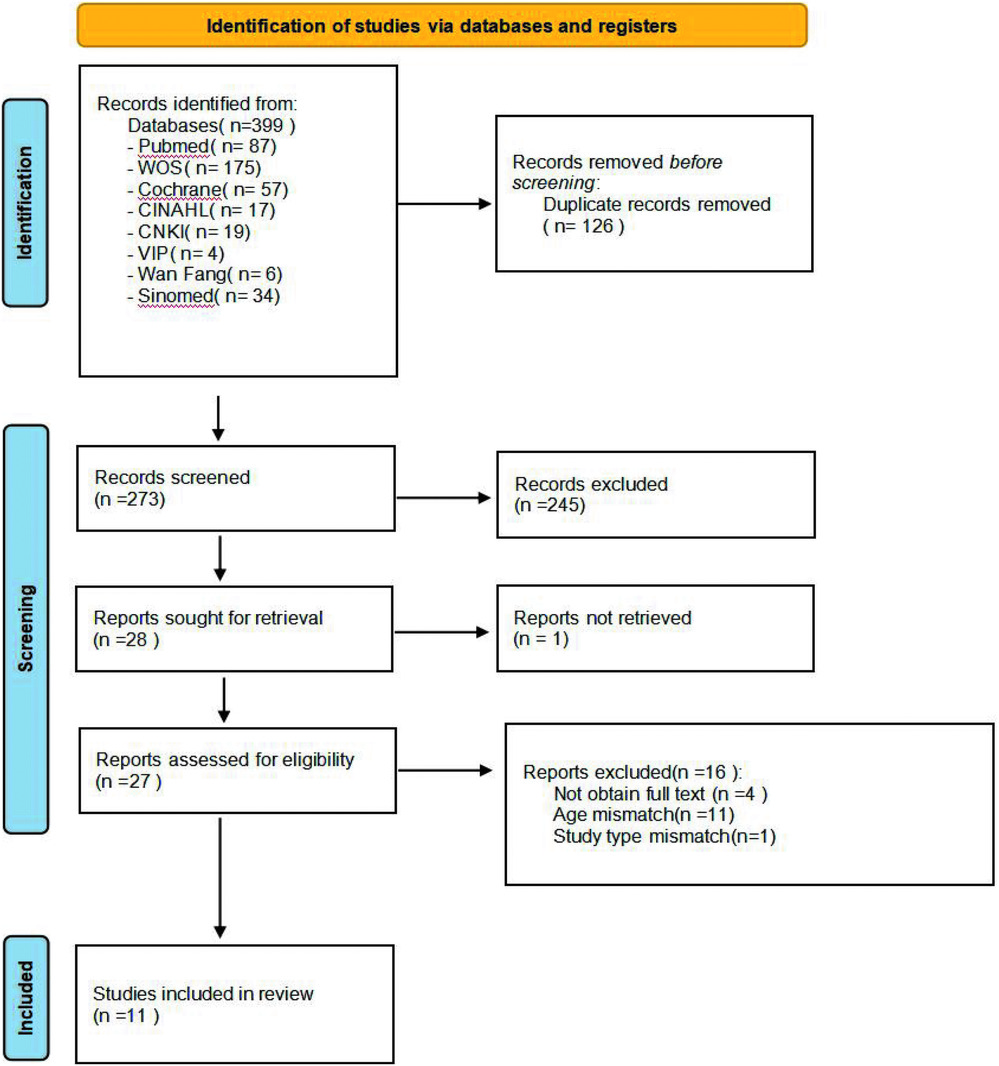
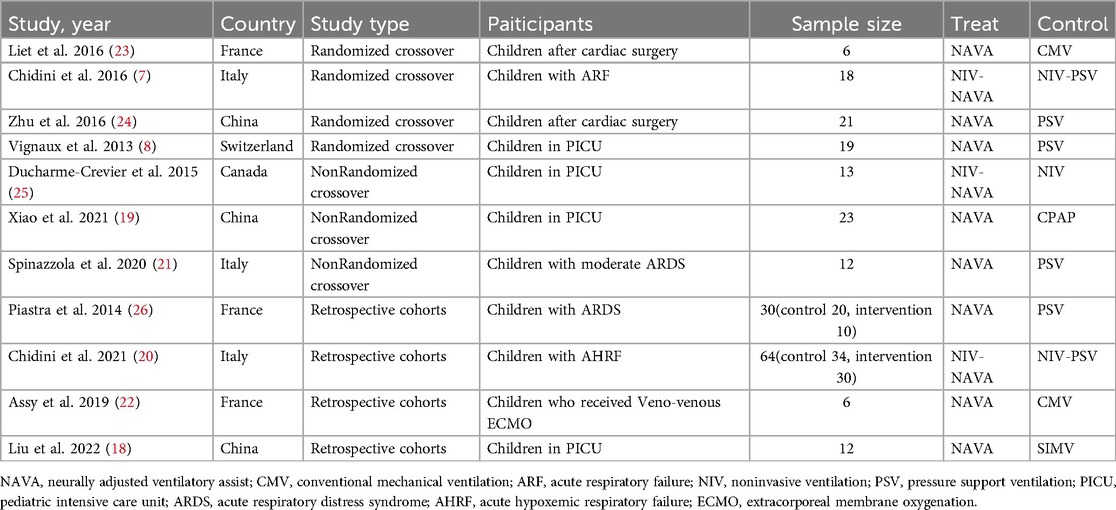

![Forest plot showing the comparison between NAVA and NOT NAVA for different studies. Each study's mean difference, standard deviation, and weight are listed, with confidence intervals indicated as horizontal lines. Diamonds represent summary effect sizes. The x-axis labels include “Favours [NAVA]” and “Favours [NOT NAVA]”.](https://www.frontiersin.org/files/Articles/1597337/fped-13-1597337-HTML/image_m/fped-13-1597337-g003.jpg)
